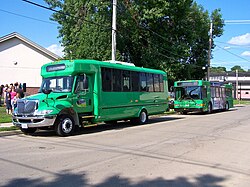Loading AI tools
Iowa-based mass transit operator From Wikipedia, the free encyclopedia
The Jule, formerly known as KeyLine Transit, is the operator of mass transit within the City of Dubuque, Iowa. The Jule offers transit bus routes throughout the city, trolley-replica transportation in Downtown Dubuque and the Port of Dubuque, and on-demand paratransit "MiniBus" service citywide. As of the 2011 rebranding, the transit system and city are now both named after Julien Dubuque. In FY 2010, the Jule recorded 371,000 rides.[1]
This article has multiple issues. Please help improve it or discuss these issues on the talk page. (Learn how and when to remove these messages)
|
 | |
 The Jule fixed route buses | |
| Founded | early 1970s |
|---|---|
| Headquarters | 950 Elm St. |
| Locale | Dubuque, Iowa |
| Service area | urban area |
| Service type | bus service, paratransit |
| Alliance | Delaware, Dubuque, & Jackson County Regional Transit Authority |
| Routes | 6 Day, 4 Weekend night, 1 Seasonal Trolly Route |
| Hubs | 3 (Dubuque Intermodal Transportation Center & 2 transfer points) |
| Fleet | 28 |
| Daily ridership | 876 |
| Fuel type | Clean diesel |
| Director | Ryan Knuckey |
| Website | The Jule |
The Jule is a municipal department of the City of Dubuque that began service following the city's takeover of the Interstate Power and Light Company's bus lines in the early 1970s. Today, the Jule is operated by the City of Dubuque, and is supervised by a director who reports to the Dubuque City Manager, Michael Van Milligen, and acts on policy as given by the Dubuque City Council, on advice of the Dubuque Transit Trustee Board.[2]
The Jule operates six Daytime bus lines: Gray, Green, Red, Medical Loop, as well as the North and South Shopping Circulators. The Jule also runs four Nightrider routes on Friday and Saturday nights from 6:00 p.m. to 2:30 a.m. All lines except the Orange run in a general pattern from downtown in the east to Kennedy Mall in the west, and then back downtown. These lines stop at all three major transfer stations: Downtown, Midtown, and the West Side. The Medical Loop runs from downtown and then north and south, stopping at no other transfer stations. The Jule operates Monday through Saturday citywide, with the earliest buses out at 6:15 a.m., and the latest out at 5:55 p.m.[3]
During the summer months, The Jule operates a trolley shuttle between the Downtown Transfer Station (West 9th & Main Streets) and the Port of Dubuque, with stops at the major tourist attractions in the area, including: Diamond Jo Casino, Grand Harbor Resort & Waterpark, Grand River Center, National Mississippi River Museum & Aquarium.
In addition to fixed-route buses, The Jule provides on-demand paratransit service through its "MiniBuses." These shuttles generally transport elderly and handicapped passengers from their homes to medical clinics, and other specific destinations. The service is available by appointment only. Jule currently has around 100 employees.
In 2018, The Jule's operations center moved to a new $6.2 million facility in Dubuque.[4]
In 2011, The Jule updated its 28 bus fleet with new clean diesel buses: four 35 feet (11 m) Heavy Duty Gillig Low Floor for Fixed Route Service, 12 30' Medium Duty ElDorado Aero Elite on International Durastar chassis for Fixed Route Service, 11 24' light duty Glaval Titan II on GMC Savanna Chassis for Paratransit, one light duty for Freightliner Sprinter for Paratransit, and two Trolleys for season fixed route trolley Service. As of 2023, The Jule consists of 18 Gillig Low Floor buses ranging from 29 feet (8.8 m) to 35 feet (11 m) for fixed-route service:[5][6]
| Fleet number(s) | Photo | Year | Manufacturer | Model | Engine | Notes |
|---|---|---|---|---|---|---|
| 2500-2504 | 2022 | Gillig | Low Floor 29' | Cummins L9 | ||
| 2680-2683 |  |
2011 | Low Floor 35' | Cummins ISL9 | ||
| 2690-2691 | 2002 | Detroit Diesel Series 40 |
| |||
| 2692-2694 |  |
Low Floor 29' |
| |||
| 2695-2698 |  |
2020 | Cummins L9 |
The Jule operates 6 daytime bus lines and 4 weekend Nightrider lines which run throughout Dubuque. Beginning in January 2014, these existing routes will be abandoned in favor of a new hub and spoke model with express routes between the 3 transfer hubs.[7]
The ridership and service statistics shown here are of fixed route services only and do not include demand response. Per capita statistics are based on the Dubuque urbanized area as reported in NTD data. Starting in 2011, 2010 census numbers replace the 2000 census numbers to calculate per capita statistics.[12]
| Ridership | Change | Ridership per capita | |
|---|---|---|---|
| 2002 | 242,264 | n/a | 3.71 |
| 2003 | 242,685 | 3.72 | |
| 2004 | 248,998 | 3.82 | |
| 2006 | 233,611 | n/a | 3.58 |
| 2007 | 207,116 | 3.17 | |
| 2008 | 269,337 | 4.13 | |
| 2009 | 293,216 | 4.49 | |
| 2010 | 331,601 | 5.08 | |
| 2011 | 346,881 | 5.11 | |
| 2013 | 377,504 | n/a | 5.57 |
| 2014 | 409,144 | 6.03 | |
| 2015 | 479,185 | 7.07 | |
| 2016 | 486,691 | 7.18 | |
| 2017 | 455,959 | 6.72 | |
| 2018 | 445,817 | 6.57 | |
| 2019 | 421,693 | 6.22 | |
| 2020 | 333,244 | 4.91 | |
| 2021 | 319,697 | 4.71 | |
Seamless Wikipedia browsing. On steroids.
Every time you click a link to Wikipedia, Wiktionary or Wikiquote in your browser's search results, it will show the modern Wikiwand interface.
Wikiwand extension is a five stars, simple, with minimum permission required to keep your browsing private, safe and transparent.